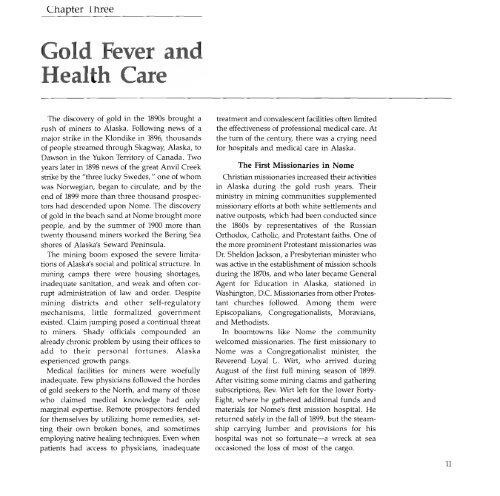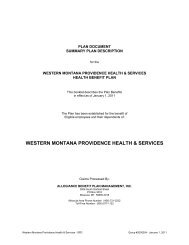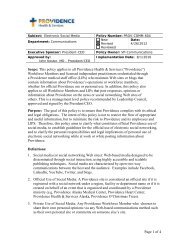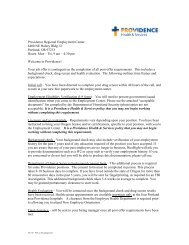Pioneering Spirit: The Sisters of Providence in Alaska
Pioneering Spirit: The Sisters of Providence in Alaska
Pioneering Spirit: The Sisters of Providence in Alaska
Create successful ePaper yourself
Turn your PDF publications into a flip-book with our unique Google optimized e-Paper software.
Chapter Three<br />
Gold Fever and<br />
Health Care<br />
<strong>The</strong> discovery <strong>of</strong> gold <strong>in</strong> the 1890s brought a<br />
rush <strong>of</strong> m<strong>in</strong>ers to <strong>Alaska</strong>. Follow<strong>in</strong>g news <strong>of</strong> a<br />
major strike <strong>in</strong> the Klondike <strong>in</strong> 1896, thousands<br />
<strong>of</strong> people streamed through Skagway, <strong>Alaska</strong>, to<br />
Dawson <strong>in</strong> the Yukon Territory <strong>of</strong> Canada. Two<br />
years later <strong>in</strong> 1898 news <strong>of</strong> the great Anvil Creek<br />
strike by the "three lucky Swedes," one <strong>of</strong> w hom<br />
was Norwegian, began to circulate, and by the<br />
end <strong>of</strong> 1899 more than three thousand prospectors<br />
had descended upon Nome. <strong>The</strong> discovery<br />
<strong>of</strong> gold <strong>in</strong> the beach sand at Nome brought more<br />
people, and by the sum m er <strong>of</strong> 1900 m ore than<br />
twenty thousand m<strong>in</strong>ers worked the Ber<strong>in</strong>g Sea<br />
shores <strong>of</strong> <strong>Alaska</strong>'s Seward Pen<strong>in</strong>sula.<br />
<strong>The</strong> m<strong>in</strong><strong>in</strong>g boom exposed the severe limitations<br />
<strong>of</strong> <strong>Alaska</strong>'s social and political structure. In<br />
m<strong>in</strong><strong>in</strong>g camps there were hous<strong>in</strong>g shortages,<br />
<strong>in</strong>adequate sanitation, and weak and <strong>of</strong>ten corrupt<br />
adm<strong>in</strong>istration <strong>of</strong> law and order. Despite<br />
m <strong>in</strong><strong>in</strong>g districts and other self-regulatory<br />
m echanism s, little form alized governm ent<br />
existed. Claim jum p<strong>in</strong>g posed a cont<strong>in</strong>ual threat<br />
to m<strong>in</strong>ers. Shady <strong>of</strong>ficials com pounded an<br />
already chronic problem by us<strong>in</strong>g their <strong>of</strong>fices to<br />
add to their p erso n al fo rtu n e s. A laska<br />
experienced growth pangs.<br />
Medical facilities for m<strong>in</strong>ers were woefully<br />
<strong>in</strong>adequate. Few physicians followed the hordes<br />
<strong>of</strong> gold seekers to the North, and m any <strong>of</strong> those<br />
who claimed medical knowledge had only<br />
marg<strong>in</strong>al expertise. Remote prospectors fended<br />
for themselves by utiliz<strong>in</strong>g hom e remedies, sett<strong>in</strong>g<br />
their own broken bones, and sometimes<br />
employ<strong>in</strong>g native heal<strong>in</strong>g techniques. Even w hen<br />
patients had access to physicians, <strong>in</strong>adequate<br />
treatment and convalescent facilities <strong>of</strong>ten limited<br />
the effectiveness <strong>of</strong> pr<strong>of</strong>essional medical care. At<br />
the turn <strong>of</strong> the century, there was a cry<strong>in</strong>g need<br />
for hospitals and medical care <strong>in</strong> <strong>Alaska</strong>.<br />
<strong>The</strong> First Missionaries <strong>in</strong> Nome<br />
Christian missionaries <strong>in</strong>creased their activities<br />
<strong>in</strong> <strong>Alaska</strong> dur<strong>in</strong>g the gold rush years. <strong>The</strong>ir<br />
m<strong>in</strong>istry <strong>in</strong> m<strong>in</strong><strong>in</strong>g communities supplem ented<br />
missionary efforts at both white settlements and<br />
native outposts, which had been conducted s<strong>in</strong>ce<br />
the 1860s by representatives <strong>of</strong> the Russian<br />
Orthodox, Catholic, and Protestant faiths. O ne <strong>of</strong><br />
the more prom <strong>in</strong>ent Protestant missionaries was<br />
Dr. Sheldon Jackson, a Presbyterian m<strong>in</strong>ister w ho<br />
was active <strong>in</strong> the establishment <strong>of</strong> mission schools<br />
dur<strong>in</strong>g the 1870s, and w ho later became General<br />
Agent for Education <strong>in</strong> <strong>Alaska</strong>, stationed <strong>in</strong><br />
Wash<strong>in</strong>gton, D.C. Missionaries from other Protestant<br />
churches followed. A m ong them were<br />
Episcopalians, Congregationalists, Moravians,<br />
and Methodists.<br />
In boomtowns like Nom e the com m unity<br />
welcomed missionaries. <strong>The</strong> first missionary to<br />
Nome was a Congregationalist m<strong>in</strong>ister, the<br />
Reverend Loyal L. Wirt, w ho arrived dur<strong>in</strong>g<br />
August <strong>of</strong> the first full m<strong>in</strong><strong>in</strong>g season <strong>of</strong> 1899.<br />
After visit<strong>in</strong>g some m<strong>in</strong><strong>in</strong>g claims and gather<strong>in</strong>g<br />
subscriptions, Rev. Wirt left for the lower Forty-<br />
Eight, where he gathered additional funds and<br />
materials for Nome's first mission hospital. He<br />
returned safely <strong>in</strong> the fall <strong>of</strong> 1899, but the steamship<br />
carry<strong>in</strong>g lum ber and provisions for his<br />
hospital was not so fortunate—a wreck at sea<br />
occasioned the loss <strong>of</strong> most <strong>of</strong> the cargo.<br />
11
















